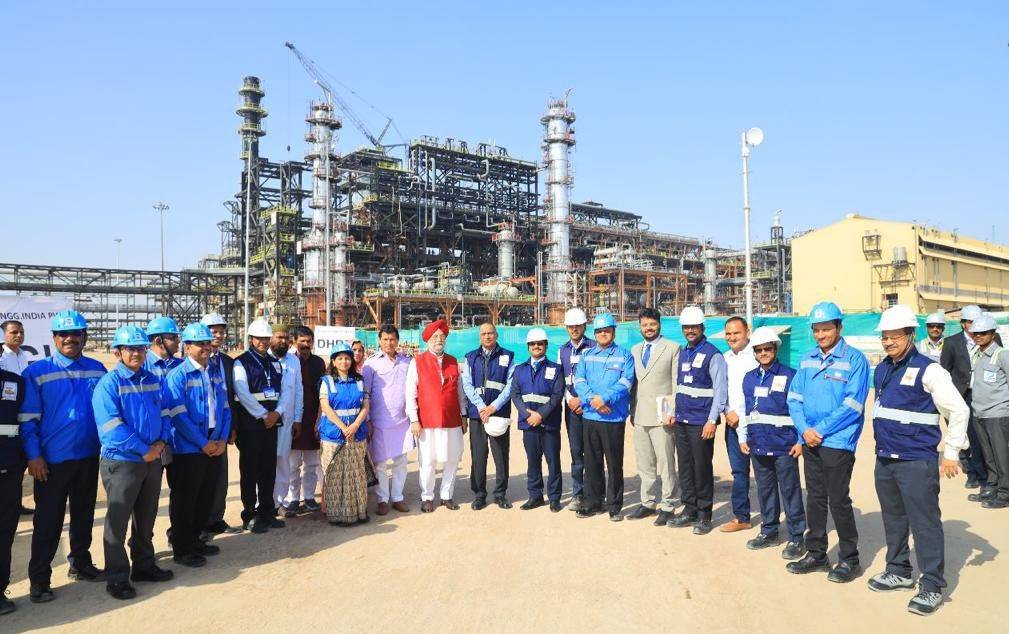
Hardeep S. Puri, Union Minister of Petroleum and Natural Gas, said at the HPCL Rajasthan Refinery Limited (HRRL) complex that the Barmer refinery will be the "Jewel of the Desert," bringing jobs, opportunities, and joy to the people of Rajasthan. The Minister reiterated that the project was designed in accordance with Prime Minister Narendra Modi's Atmanirbhar Bharat and Make in India visions.
The project was first proposed in 2008 and was approved in 2013. The Prime Minister of India reconfigured it and began construction in 2018. Despite the severe setback caused by the COVID 19 pandemic, more than 60% of the project has been completed.
According to the Union Minister of Petroleum and Natural Gas, the HRRL refinery complex will process 9 MMTPA of crude and produce more than 2.4 million tonnes of petrochemicals, lowering the import bill for petrochemicals. According to the Minister, this project will not only serve as an anchor industry for an industrial hub in western Rajasthan, but it will also help India achieve its goal of achieving 450 MMTPA refining capacity by 2030.
The project will bring self-reliance to India in terms of import substitution of petrochemicals, Puri added. Current imports are in a tune of Rs 95000 cr, the complex post commission shall reduce the import bill by Rs 26000 cr. Underlining the socio-economic benefits of the project in terms of employment generation and infrastructure development, the Minister said that the project has engaged about 35,000 workers in and around the complex. Further, about 1,00,000 workers are engaged indirectly.
In addition, a co-ed school up to the 12th grade with a capacity of 600 students will be established. "The school site has been purchased, the architectural layout has been finalized, and construction has begun. It is expected to be finished by December 2023. This will be the first school in the area," said the Minister.
Puri stated that a 50-bed hospital is also being built. The land has been purchased, and construction is scheduled to begin in December 2023. Speaking about the increased connectivity in the region as a result of the refinery's establishment, the Minister stated that the construction of roads for the nearby villages will aid in improving connectivity in the region.
The Minister also mentioned the project's environmental benefits. He stated that a wetland habitat for migratory birds such as the Demoiselle crane is being created within the refinery complex. Other projects that will benefit the environment include the revitalization of natural surface water bodies and the planting of avenues from Pachpadra to Khed.
AFRI is also conducting research on the complex's desert lands to convert them into green belts due to the high salt content of the land. The Minister stated that once the recommendations are received, the plantation will be carried out with the assistance of the Forest Department under deposit works. When it comes to increased revenue as a result of this project, the total annual contribution of the petroleum sector to the state exchequer will be around Rs 27,500 cr, with the refinery complex contributing Rs 5,150 cr. Furthermore, exports of the products worth approximately Rs 12,250 crore will earn valuable foreign exchange.
The project is also expected to boost regional industrial development. During the construction phase, the project will lead to the expansion of the construction industry, mechanical fabrication shops, machining and assembly units, supply of heavy equipment such as cranes, trailers, JCBs, and so on, transportation and hospitality industry, automotive spares and services, and sandblasting and painting shops, among other things.
downstream of Petchem Small-Scale Industries such as Injection Moulding: for Furniture, Crockery, Storage tanks, Bulk containers; Auto Molding, Packaging, Medical Equipment, and so on; Blow Moulding: for making containers, and so on; Rotomoulding: water tanks, containers, and so on; Films include cement bags, wrapping material, adhesive tapes, and other items such as tyres, pharmaceuticals, detergents, perfumes, inks, nail polish, paint thinners, and so on.
It will also spur the growth of major downstream industries such as chemical, petrochemical, and plant equipment manufacturing. HRRL will produce Butadiene, a raw material used to make Rubber, which is widely used in the tyre industry. This will give the automotive industry a boost.
Currently, India imports approximately 300 KTPA of synthetic rubber. With the availability of the key raw material, Butadiene, there is significant potential for reducing Synthetic Rubber import dependency. Butadiene will play a catalytic role in the automotive industry in India, which is on a high growth trajectory.










